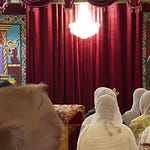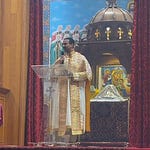I thought it would be demonstrative to show you an atypical Sunday at Virgin Mary’s EOTC in South Central L.A., and a typical Sunday. The former has given us so much content already, and this second high-quality video from our brother in Christ nahu’senay will be our last from the atypical Sunday.
Here Dcn. zéna bluy hadees recites the Magnificat, according to the Greek Rite. In our ge’ez Rite, this prayer is one of the many compiled within a collection known as tselot ze’zewtr (ge’ez) / ye’zewtr tselot (Amharic) (prayers for always; daily prayers). It is found in the Gospel According to St. Luke, Chapter 1 Verses 46-55:
And Mary said, My soul magnifies the Lord, And my spirit rejoices in God my Savior. For he has regarded the low estate of his handmaiden: for, behold, from henceforth all generations shall call me blessed. For he that is mighty has done to me great things; and holy is his name. And his mercy is on them that fear him from generation to generation. He has showed strength with his arm; he has scattered the proud in the imagination of their hearts. He has put down the mighty from their seats, and exalted them of low degree. He has filled the hungry with good things; and the rich he has sent empty away. He has helped his servant Israel, in remembrance of his mercy; As he spoke to our fathers, to Abraham, and to his seed for ever.
It is often committed to heart in ge’ez. If you can do this fully, do so. If you cannot, do it in part. If you cannot, do it in English, or whatever language of yours is strongest. Here’s the ge’ez:
ታዐብዮ ነፍስየ ለእግዚአብሔር ወትትሐሠይ መንፈስየ በአምላኪየ ወመድኃኒየ እስመ ርእየ ሕማማ ለአመቱ ናሁ እምይእዜሰ ያስተበፅዑኒ ኵሉ ትውልድ እስመ ገብረ ሊተ ኃይለ ዐቢያተ ወቅዱስ ስሙ ወሣህሉኒ ለትውልደ ትውልድ ለእለ ይፈርህዎ ወገብረ ኃይለ በመዝራዕቱ ወዘረዎሙ ለእለ ያዐብዩ ኅሊና ልቦሙ ወነሠቶሙ ለኃያላን እመናብርቲሆሙ አዕበዮሙ ለትሑታን ወአጽገቦሙ እምበረከቱ ለርኁባን ወፈነዎሙ ዕራቆሙ ለብዑላን ወተወክፎ ለእስራኤል ቍልዔሁ ወተዘከረ ሣህሎ ዘይቤሎሙ ለአበዊነ ለአብርሃም ወለዘርዑ እስከ ለዓለም።
On a typical Sunday, like this past Christian Sabbath, Dcn. daweet ingida’werq preached in English before the great congregation, including a mixed-assembly of adults and youth, Jonathan Simmons, Esq. taught a swarm of high school and college age students in a room adjacent to but outside the sanctuary, and his beatitude abune bernabas did his thing counseling visitors whilst standing outside after the eucharistic liturgy.
Dcn. daweet told us about the Prophet Ezekiel being told to eat the scroll of the instruction of yahweh and doing so (chapter 3), and of the dry bones (chapter 37) being told likewise with slightly different language, but still doing so. Jonathan shared with us the Acts of the Apostles chapters 1 & 2, after summarizing the culmination of the Gospel According to St. John, which his class had recently completed reading aloud. The ascension, or going up into the sky, of Jesus Christ, the fiery homily of repentance from St. Peter at the third hour (9a.m.; btw we still speak this way in Amharic), and the hierarchical communal living of the apostles and their disciples make an appearance.
After my wife sang a typical spiritual song for our bishop, in ge’ez, he interpreted it for those of us present. It is rooted in the Gospel According to St. John Chapter 17 Verse 11 (LEB), “Holy Father, keep them in your name, which you have given to me, so that they may be one, just as we are.” Like Luke’s, ““Father, forgive them, for they do not know what they are doing”, and Genesis’ “be fruitful and multiply, swarm on the earth and multiply in it”, these are intercessory prayers, and a command, that are spoken once but last forever and ever.
This teaching reminded me of a teaching by Fr. Paul Nadim Tarazi. Fr. Paul constantly stresses the importance of functionality in scripture, and switching the focus from the temporary to the eternal. Here is 2 Kings 18:1-6 LEB
It happened in the third year of Hoshea the son of Elah king of Israel, that Hezekiah the son of Ahaz king of Judah became king. He was twenty-five years old when he became king, and he reigned twenty-nine years in Jerusalem. The name of his mother was Abi, the daughter of Zechariah. He did right in the eyes of Yahweh according to all that David his ancestor had done. He removed the high places, and he smashed the stone pillars; he cut down the poles of Asherah worship and demolished the bronze serpent which Moses had made, for up to those days the Israelites were offering incense to it and called it Nehushtan. He trusted in Yahweh the God of Israel; there was no one like him, before or after, among all the kings of Judah. He held on to Yahweh; he did not depart from following him, and he kept his commands that Yahweh had commanded Moses.
The nehash, in biblical Hebrew, is a snake. The month closest to August in the Western Calendar is called, in ge’ez, nehasé, which means bronze. This is not a mistake. The nehushtan, in biblical Hebrew, is a bronze snake on a stick. In Genesis, snake bad. In Numbers snake bad, then snake good. In Kings, snake bad. In John, snake good again.
What gives? What does this mean? What is our snake? Think of our icons, priestly vestments, and even the bishop’s staff! abune bernabas quickly directed the glory back to God, when the song was sung in the bishop’s honor. But how many bishops would do likewise? Everything blessed can be cursed, and vice-versa. Everything mundane and profane can become holy, and vice-versa.
Be functional. Redound glory upon and to God, in every time and in every space, now and ever, unto ages of ages…









